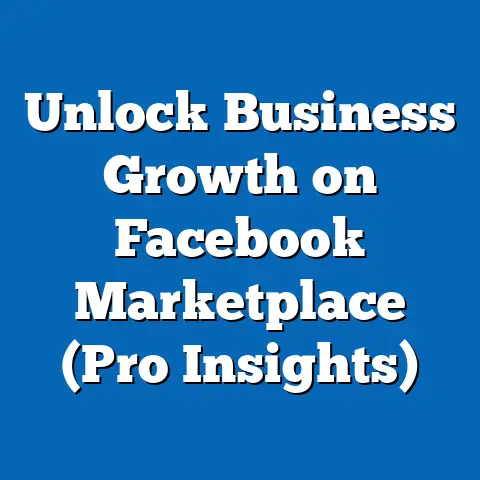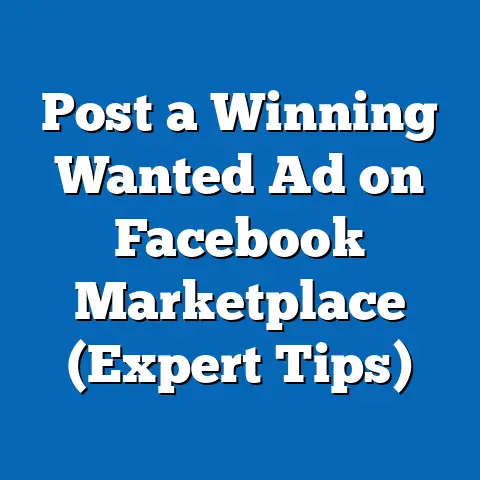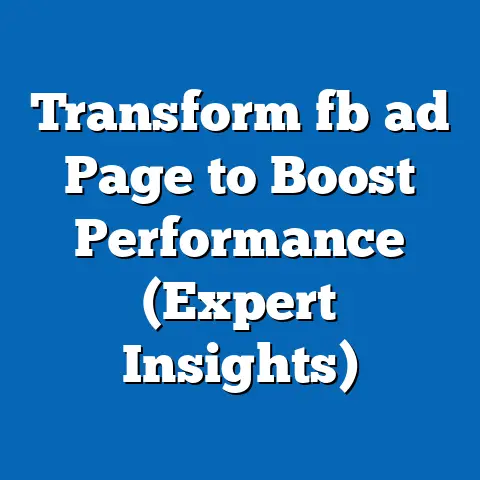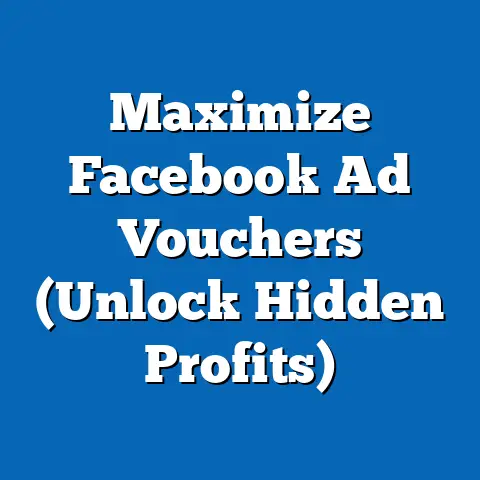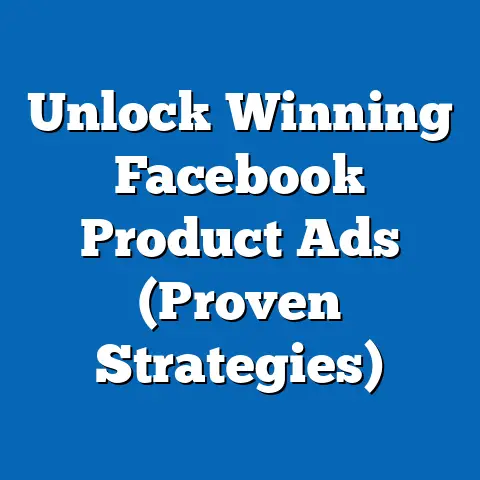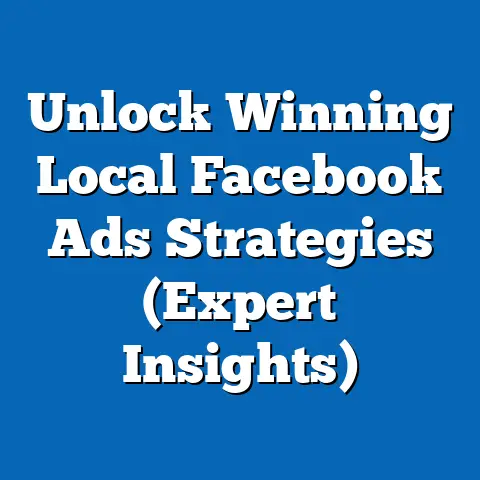Build Facebook Ads List Fast (Essential Strategies)
In the fast-paced world of digital marketing, resilience is key. The online landscape is constantly evolving, demanding that marketers adapt and innovate to stay ahead. One of the most enduring and valuable assets you can cultivate is a robust email list built through Facebook Ads. Think of it as your own little goldmine of potential customers, ready to be engaged and converted.
I’ve seen firsthand how a well-crafted Facebook Ads strategy can transform a struggling business into a thriving one, and a large part of that success hinges on the ability to quickly build a quality email list. It’s not just about amassing numbers; it’s about attracting the right people, those genuinely interested in what you have to offer. Imagine launching a new product and having a ready-made audience eager to hear about it, ready to buy. That’s the power of a well-nurtured email list.
However, the path to building that list isn’t always smooth. It requires a strategic approach, a deep understanding of your audience, and a willingness to experiment and adapt. This article will serve as your roadmap, outlining essential strategies for rapidly growing your Facebook Ads list, turning those potential customers into loyal subscribers and ultimately, driving significant ROI. Let’s dive in!
1: Understanding Your Audience
Before you even think about crafting an ad or designing a landing page, you need to deeply understand who you’re trying to reach. This isn’t just about surface-level demographics; it’s about understanding their needs, desires, pain points, and online behavior. Think of it as creating a detailed profile of your ideal customer – what keeps them up at night? What are their aspirations? What kind of content do they engage with?
In-depth audience research is the cornerstone of effective ad targeting. The more you know about your audience, the more precisely you can tailor your ads to resonate with them. This leads to higher click-through rates, lower ad costs, and ultimately, a more effective list-building strategy.
So, how do you gather these crucial insights? Here are a few essential tools and methods:
- Facebook Audience Insights: This free tool within Facebook Ads Manager is a goldmine of information. It allows you to analyze the demographics, interests, behaviors, and even the purchase patterns of people connected to your page or those within specific target audiences. I’ve spent countless hours exploring Audience Insights, uncovering hidden interests and behaviors that dramatically improved my ad targeting.
- Surveys: Don’t underestimate the power of directly asking your target audience what they want. Create a simple survey using tools like SurveyMonkey or Google Forms and offer an incentive for participation, such as a discount or a free resource.
- Customer Feedback: Pay close attention to what your existing customers are saying. Read reviews, analyze customer support tickets, and engage in conversations on social media. This feedback can provide valuable insights into their needs and pain points.
- Website Analytics: Tools like Google Analytics can provide a wealth of information about your website visitors, including their demographics, interests, and behavior on your site. This data can help you understand who’s already interested in your product or service and what they’re looking for.
Let’s say you’re selling online yoga classes. Through audience research, you might discover that your ideal customer is a woman between 25 and 45, interested in health and wellness, mindfulness, and sustainable living. They’re likely to follow yoga influencers on Instagram, read articles about healthy eating, and participate in online fitness communities. Armed with this knowledge, you can craft ad copy that speaks directly to their interests, highlighting the benefits of your yoga classes for stress relief, flexibility, and overall well-being. You can also target your ads to people who follow specific yoga pages or have expressed interest in related topics.
Key Takeaway: Thorough audience research is non-negotiable. The more you understand your target audience, the more effective your ads will be. Take the time to gather data, analyze insights, and create a detailed profile of your ideal customer. This will be your guiding light as you develop your list-building strategy.
2: Creating Compelling Lead Magnets
A lead magnet is essentially an irresistible offer that you give away in exchange for someone’s email address. Think of it as a “bribe” – a valuable piece of content or resource that entices people to subscribe to your list. It’s a crucial component of any successful list-building strategy because it provides immediate value to potential subscribers, demonstrating your expertise and building trust.
The key to creating a compelling lead magnet is to address a specific pain point or provide a solution to a problem that your target audience is facing. It should be something they genuinely want and find valuable. The more relevant and useful your lead magnet is, the more likely people are to hand over their email address.
Here are some of the most effective types of lead magnets for Facebook users:
- eBooks: A well-written eBook that provides in-depth information on a specific topic can be a highly valuable lead magnet. Make sure it’s well-designed, easy to read, and packed with actionable advice.
- Checklists: Checklists are simple, practical, and highly effective. They provide a step-by-step guide to achieving a specific goal or completing a task.
- Webinars: Hosting a live webinar on a topic of interest to your target audience is a great way to generate leads and build relationships. Offer valuable content, answer questions, and promote your products or services.
- Exclusive Discounts: Offering a discount on your products or services is a classic lead magnet that always works well. People love saving money, so this is a great way to incentivize them to subscribe to your list.
- Free Templates: Templates for social media posts, email marketing campaigns, or website design can be a valuable lead magnet for businesses and marketers.
- Case Studies: Sharing a compelling case study that demonstrates the results you’ve achieved for your clients can be a powerful way to attract new leads.
- Free Trials: If you offer a software or SaaS product, offering a free trial is a great way to let people experience the value of your product firsthand.
I remember working with a small bakery that was struggling to build their email list. We created a lead magnet called “The Ultimate Guide to Baking Perfect Chocolate Chip Cookies.” It included tips on choosing the right ingredients, mastering baking techniques, and troubleshooting common problems. The response was incredible! People were eager to download the guide, and the bakery’s email list grew exponentially.
Here are a few tips for creating lead magnets that convert:
- Focus on a Specific Problem: Don’t try to cover too much ground. Focus on addressing a specific pain point or providing a solution to a specific problem.
- Make it Actionable: Provide practical advice and actionable steps that people can implement immediately.
- Keep it Concise: People are busy, so keep your lead magnet concise and to the point.
- Make it Visually Appealing: Design your lead magnet to be visually appealing and easy to read.
- Promote it Effectively: Use your Facebook Ads to promote your lead magnet to your target audience.
Key Takeaway: A compelling lead magnet is the engine that drives your list-building efforts. Invest time and effort in creating a valuable resource that your target audience will love. Promote it effectively through your Facebook Ads, and watch your email list grow.
3: Optimizing Facebook Ads for Lead Generation
Now that you have a clear understanding of your audience and a compelling lead magnet, it’s time to create Facebook Ads that drive traffic to your landing page and convert visitors into subscribers. This is where the rubber meets the road, and it’s crucial to optimize your ads for maximum impact.
Designing Facebook Ads specifically for lead generation requires a strategic approach. You need to craft compelling ad copy, choose visually appealing images or videos, and target your ads to the right audience. Here are some key elements to consider:
- Clear and Compelling Calls-to-Action (CTAs): Your CTA is the most important part of your ad. It tells people exactly what you want them to do. Use clear and concise language, such as “Download Now,” “Sign Up Today,” or “Get Your Free Guide.” Make sure your CTA stands out visually and is easy to click.
- Compelling Ad Copy: Your ad copy should grab attention, highlight the benefits of your lead magnet, and create a sense of urgency. Use strong verbs, persuasive language, and social proof to encourage people to click.
- Visually Appealing Images or Videos: Visuals are crucial for capturing attention on Facebook. Use high-quality images or videos that are relevant to your lead magnet and your target audience.
- Targeted Audience: As we discussed earlier, targeting your ads to the right audience is essential for success. Use Facebook’s targeting options to reach people who are most likely to be interested in your lead magnet.
- A/B Testing: A/B testing is the process of testing different versions of your ads to see which performs best. Test different ad copy, images, CTAs, and targeting options to optimize your ads for maximum performance.
- Ad Formats: Experiment with different ad formats to see which works best for lead generation. Lead ads are specifically designed for collecting leads directly on Facebook, while carousel ads allow you to showcase multiple images or videos in a single ad.
I’ve found that using a personal anecdote in my ad copy can significantly increase engagement. For example, instead of just saying “Download our free eBook,” I might say “I used to struggle with [problem], but then I discovered [solution]. Now I’m sharing my secrets in this free eBook!” This makes the ad more relatable and encourages people to click.
Here are some best practices for ad formats that work well for lead generation:
- Lead Ads: Lead ads are a great option because they allow people to sign up for your email list without leaving Facebook. This makes the process quick and easy, which can lead to higher conversion rates.
- Carousel Ads: Carousel ads are a great way to showcase multiple benefits of your lead magnet or to highlight different aspects of your product or service.
- Video Ads: Video ads can be highly engaging and effective for capturing attention. Use video to showcase the value of your lead magnet or to tell a story that resonates with your target audience.
Key Takeaway: Optimizing your Facebook Ads for lead generation is an ongoing process. Continuously test different ad creatives, targeting options, and placements to improve performance. Pay close attention to your metrics, and make adjustments as needed.
4: Building Landing Pages that Convert
Your Facebook Ads are designed to drive traffic to your landing page, but it’s your landing page that ultimately converts visitors into subscribers. A high-converting landing page is essential for maximizing the effectiveness of your list-building efforts.
A landing page is a dedicated page on your website that is specifically designed to capture leads. It should be focused on a single goal – getting people to subscribe to your email list. It should be free of distractions and designed to guide visitors towards that goal.
Here are some tips for creating high-converting landing pages:
- Clear and Concise Headline: Your headline should grab attention and clearly communicate the value of your lead magnet.
- Compelling Copy: Your copy should highlight the benefits of your lead magnet and create a sense of urgency. Use strong verbs, persuasive language, and social proof to encourage people to sign up.
- Visually Appealing Design: Your landing page should be visually appealing and easy to read. Use high-quality images or videos, clear fonts, and plenty of white space.
- Simple Form: Keep your form as short as possible. Only ask for the information you absolutely need, such as name and email address.
- Clear Call-to-Action (CTA): Your CTA should be clear, concise, and visually prominent. Use action-oriented language, such as “Download Now” or “Sign Up Today.”
- Mobile Optimization: Given the mobile-centric nature of Facebook users, it’s crucial to optimize your landing page for mobile devices. Make sure it’s responsive, easy to navigate, and loads quickly on mobile devices.
- Fast Loading Times: People are impatient, so your landing page needs to load quickly. Optimize your images, minify your code, and use a content delivery network (CDN) to improve loading times.
I once worked with a client who had a beautiful website but a terrible landing page. Their Facebook Ads were driving plenty of traffic, but very few people were signing up for their email list. After redesigning their landing page with a clear headline, compelling copy, and a simple form, their conversion rate increased by over 300%!
Here are some examples of effective landing pages:
- HubSpot: HubSpot’s landing pages are known for their clean design, compelling copy, and clear CTAs.
- Neil Patel: Neil Patel’s landing pages are data-driven and focused on providing value to visitors.
- Unbounce: Unbounce’s landing pages are visually appealing and optimized for mobile devices.
Key Takeaway: Your landing page is the final piece of the puzzle. Invest time and effort in creating a high-converting landing page that effectively captures leads. Test different elements, optimize for mobile, and ensure fast loading times.
5: Leveraging Retargeting Strategies
Retargeting is a powerful strategy for enhancing your list-building efforts by reaching users who have already interacted with your ads or visited your website. It’s like giving them a gentle nudge to remind them of what they missed and encouraging them to subscribe to your list.
Retargeting works by placing a pixel on your website or in your Facebook Ads. This pixel tracks the behavior of visitors, allowing you to create custom audiences based on their actions. For example, you can create a custom audience of people who visited your landing page but didn’t sign up for your email list.
Once you’ve created your custom audience, you can create retargeting ads that are specifically designed to encourage them to subscribe. These ads might offer additional value, remind them of what they missed, or address any concerns they might have.
Here are some strategies for crafting retargeting ads that encourage subscriptions:
- Offer Additional Value: Provide a bonus or incentive for signing up, such as a free report, a discount, or access to exclusive content.
- Remind Them of What They Missed: Highlight the benefits of your lead magnet and remind them of the value they’re missing out on by not subscribing.
- Address Their Concerns: If you know that people are hesitant to sign up because of privacy concerns, address those concerns directly in your ad copy.
- Use Social Proof: Showcase testimonials or reviews from satisfied subscribers to build trust and credibility.
I’ve found that using custom audiences and lookalike audiences in my retargeting efforts can significantly improve performance. Custom audiences allow you to target people who have already interacted with your business, while lookalike audiences allow you to target people who are similar to your existing customers.
For example, you can create a lookalike audience based on your existing email subscribers and target them with ads promoting your lead magnet. This is a great way to reach new people who are likely to be interested in your offer.
Key Takeaway: Retargeting is a powerful tool for enhancing your list-building efforts. Use it to reach people who have already interacted with your business and encourage them to subscribe to your list.
Conclusion
Building a Facebook Ads list quickly isn’t just about speed; it’s about strategy, endurance, and providing real value to your audience. We’ve covered essential strategies, from understanding your audience and crafting compelling lead magnets to optimizing your ads and leveraging retargeting.
Remember, the foundation of success lies in deeply understanding your audience, providing them with valuable resources, and continuously optimizing your efforts based on data and insights. While rapid list-building is achievable, it requires a commitment to these core principles.
A well-built email list has the power to transform your marketing efforts. It gives you direct access to a highly engaged audience, allowing you to build relationships, promote your products or services, and drive significant ROI. So, take these strategies, implement them diligently, and watch your Facebook Ads list grow into a valuable asset for your business. The potential is there – now go unlock it!

